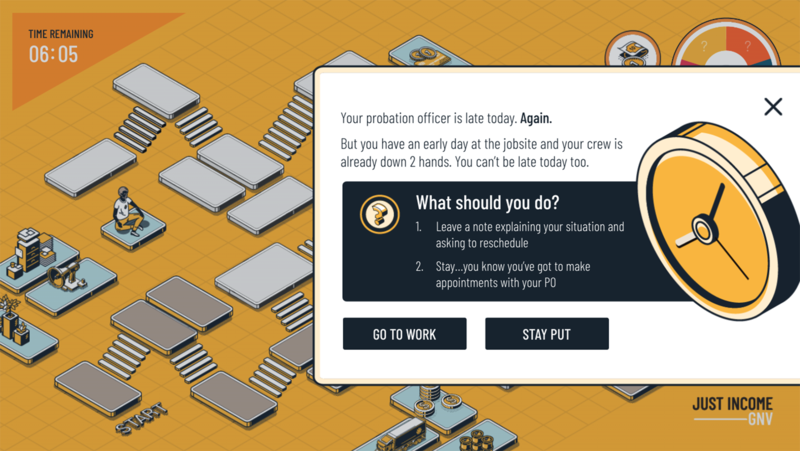New reentry simulator highlights the perils of life after prison
"ReEntry" was created by formerly incarcerated people to communicate the contradictions, difficult decisions, and unexpected events that make staying out of prison nearly impossible for people under community supervision.
by Brian Nam-Sonenstein and Lucius Couloute, December 5, 2023
It’s not easy leaving prison. Most people go through the reentry process with little to no preparation, planning, or support and face a barrage of rules that turn everyday activities into trapdoors to incarceration. But because many people have no idea what it’s like to live under supervision, it’s easy for the media, politicians, and law enforcement to capitalize on the fiction that recidivism rates1 reflect personal – and not institutional – failure.
Thankfully, a Community Spring program known as Just Income, which is led by formerly incarcerated people, offers a new way to understand these experiences through a simulator they designed called “ReEntry: A Look at the Journey Back to Life.” We think it can help people better understand the profoundly burdensome hurdles and contradictions facing people leaving incarceration.

In “ReEntry,” you have seven minutes to navigate life on probation while adhering to the terms of your release. Unfortunately, three violations of your probation conditions will send you back behind bars. Such non-criminal or “technical” violations are a significant engine of incarceration for people on probation and parole and, indeed, the system as a whole: supervision violations account for 42% of prison admissions nationwide.
You start the simulator with $60 in your pocket and instructions to meet with your probation officer at regular intervals. But within seconds of your journey, the simulator asks you to “spin the wheel,” which presents you with difficult decisions and circumstances out of your control — many of which pose imminent threats to your freedom. Your $60 disappears quickly, of course, as various fees and everyday costs start to pile up.
For example, the simulator demonstrates how, in many states, a single monthly probation fee would eat up your entire $60, and you’ll be hit with a violation if you can’t pay. What happens when a traffic accident blocks the road on your way home, and you miss curfew? Do you spend your last few dollars getting an ID or try to wing it without one? Do you take your friend’s under-the-table job offer and make the money you desperately need, or turn it down to avoid being punished for unreported income? These scenarios demonstrate the contradictory nature of reentry and shed light on the artificial roadblocks facing those simply trying to get their lives on track.
Soon, it’s time for your appointment with your probation officer. They’re running behind, but you can’t afford to be late for work. Do you wait for your meeting, or do you leave for work? As the simulator continues, it becomes clear why, in states like Colorado, two-thirds of people who had their probation revoked in 2019 had at least one missed appointment (as compared to less than a quarter of those who successfully completed probation).
Reentry is an inherently insecure and uncertain experience; you never quite know which twist or turn might lead you back to jail or prison. Spinning the wheel is, on some level, a profound metaphor for the lack of control and agency afforded to criminalized people.
We’ve run through the simulator dozens of times and have yet to successfully navigate probation—a taste of how “unwinnable” it is for people in the system. Anyone who spends time with “ReEntry” will find themselves feeling frustrated and defeated because that’s the experience of being under supervision. Give it a try and see if you can make it through unscathed.
Footnotes
-
Recidivism rates are an often-used but problematic measure; there are various definitions and none of them say much about any actual risk individuals pose to public safety or their likelihood of success after release. ↩



